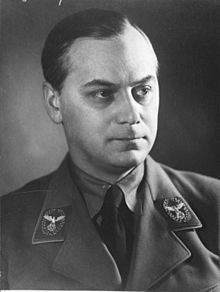Nordische Gesellschaft
 Alfred Rosenbergin 1939 | |
| Formation | 1921 |
|---|---|
| Type | Association |
| Purpose | Strengthening German-Nordic cultural and political cooperation |
| Location |
|
| Leader | Alfred Rosenberg |
Main organ | Pressedienst Nord and Der Norden |
TheNordische Gesellschaft( "Nordic Society" ) was an association founded in 1921, with the objective of strengthening German-Nordic cultural and political cooperation. It was based inLübeck,Germany.The association had both German andScandinavianmembers. After theNazi Party's takeover of Germany in 1933, theNordische Gesellschaftcame under the control ofAlfred Rosenberg.A new board was formed. Rosenberg's ambition was that the organization could be utilized for the Nazi cause.Heinrich Himmlerbecame a member of the board.[1]
As of 1940, the association had 40 local branches in different parts of Germany. The association published a notable number of books and brochures which were distributed in Scandinavia.[2]
During theSecond World War,it ran two publications,Pressedienst NordandDer Norden,directed towards influencing the political debate in the Scandinavian countries towards a pro-German position.[3]
Der Norden
[edit]Der Norden('The North') was the flagship of the publishing activities ofNordische Gesellschaft.Initially known asDer Nordische Aufseher,it got the nameDer Nordenin 1935.[1]It dealt mainly with Nordic issues and actively tried to foster a concept of a commonBaltic Seahistorical and cultural heritage, based on the legacy of theHanseatic league.The publication presented the Hanseatic period as a golden era of the region. Several Scandinavian writers had their articles published inDer Norden.
Der Nordenhad a monthly edition of around 6,000 to 7,000. It is assumed that the last issue was published in October 1944.[4]
Pressedienst Nord
[edit]Pressedienst Nord('Press Service North') was published weekly. In the summer of 1940 it had a pressrun of 3000 weekly. Its pressrun gradually increased until the spring of 1941. From that point until February 1945, its pressrun was 10,000 weekly. Its articles were mainly inGerman languagebut some were in Scandinavian languages, especially inNorwegian.
The articles dealt mainly with Nordic issues. The publishing house did a conscious effort to include Scandinavian writers, such asKnut Hamsun,Erling BjørnsonandKarl Olivecrona.
The publication was rather thin, and printed on cheap paper. Images were rare, and generally limited to politicalcaricatures.[3]
Wirtschaftswart Nord
[edit]A third publication issued by the association, with much smaller edition, wasWirtschaftswart Nord('Economy Warden North'). The publication was dedicated toeconomics,and was not used for political purposes like the other two main publications of the association.[2]
Brochures
[edit]A sizeable amount of brochures were published by the association; most of them were part of the seriesVeröffentlichungen der Nordischen Gesellschaft zum Zeitgeschehen.One brochure in the seriesEngland oder Deutschland?('England or Germany?'), written byKarl Olivecrona,had a print run of 80,000 copies. Published in 1941, was a translation from itsSwedishoriginal,England eller Tyskland?[2][5]
Cultural branch
[edit]A special 'cultural branch' was set up under the leadership of Heinrich Jessen, to facilitate contacts with the cultural and academic sphere in the Scandinavian countries. The cultural branch arranged yearly summer congresses in Lübeck,Reichstagung zur Sommersonnenwende.[2]
Activities in Sweden
[edit]The cultural branch worked actively throughout the war years to foster contacts with Swedish academics and artists. This work was often done in close cooperation with the cultural section of the German diplomatic representation inStockholm.The activities included study visits, lectures and concerts in Germany and tours of German scholars and artists in Sweden. The branch also maintained correspondence with a large number of Swedish individual scholars, painters, musicians and artists. The branch sent large amounts of pro-German literature to these people, whom in turn distributed this literature amongst friends and colleagues. According to a Swedish state survey conducted directly after the war, the work ofNordische Gesellschaftplayed an important role in the German cultural propaganda work during the war.[6]
Activities in Norway
[edit]Johan BojerandBarbra Ringplayed key roles in theNorwegianactivities ofNordische Gesellschaftduring the 1930s. Other important individuals in the networks of the association wereRonald Fangen,Tore ØrjasæterandMikkjel Fønhus.
During the first six months of theGerman occupation of Norway,the organization was very active in trying to utilize the bonds forged with Norwegian writers during the 1930s. This endeavour was however largely unsuccessful. The most prominent writer who retained contacts with the association wasÅsmund Sveen.Vidkun Quisling'sNasjonal Samlingparty never had any formal contacts withNordische Gesellschaft.[7]
Other organizations
[edit]Nordische Gesellschaftwas however not the sole organization dedicated to Nordic-German cultural exchange at the time. It faced competition from theHamburg-basedDeutsch-Nordische Gesellschaftand, to a lesser extent,Kulturabteilung des Auswärtigen AmtesinBerlin.[1]
References
[edit]- ^abcAndersson, Greger; Geisler, Ursula (2007).Myt och propaganda: musiken i nazismens tjänst i Sverige och Tyskland(PDF).Skriftserie (Forum för levande historia), 1653-5332; 5 (in Swedish). Stockholm: Forum för levande historia.SELIBR11360998.
- ^abcdKjellberg, Georg K:son (1946).Den tyska propagandan i Sverige under krigsåren 1939-1945.Statens offentliga utredningar, 0375-250X; 1946:86 (in Swedish). Stockholm. p. 17.SELIBR13576330.
{{cite book}}:CS1 maint: location missing publisher (link) - ^abKjellberg, Georg K:son (1946).Den tyska propagandan i Sverige under krigsåren 1939-1945.Statens offentliga utredningar, 0375-250X; 1946:86 (in Swedish). Stockholm. p. 223.SELIBR13576330.
{{cite book}}:CS1 maint: location missing publisher (link) - ^Kjellberg, Georg K:son (1946).Den tyska propagandan i Sverige under krigsåren 1939-1945.Statens offentliga utredningar, 0375-250X; 1946:86 (in Swedish). Stockholm. p. 224.SELIBR13576330.
{{cite book}}:CS1 maint: location missing publisher (link) - ^Olivecrona, Karl (1941).England oder Deutschland?(in German). Lübeck: Reichskontor der Nordischen Gesellschaft.SELIBR2945921.
- ^Kjellberg, Georg K:son (1946).Den tyska propagandan i Sverige under krigsåren 1939-1945.Statens offentliga utredningar, 0375-250X; 1946:86 (in Swedish). Stockholm. p. 18.SELIBR13576330.
{{cite book}}:CS1 maint: location missing publisher (link) - ^"NorgesLexi".Archived fromthe originalon 2011-05-25.Retrieved2009-12-29.
